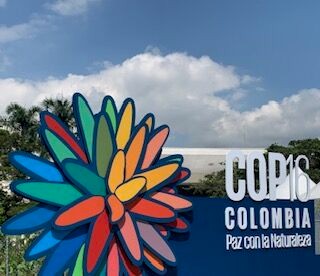In late October, OTS Director for Strategic Engagement Carlos Silva traveled to Cali as part of a delegation of more than 20 people from the Ecological Society of America (ESA) to attend COP16, the latest round of negotiations among 196 signatory nations to the Convention on Biological Diversity.
The Convention is an international treaty under the U.N. framework that explicitly recognizes that Earth’s biological resources are vital to humanity’s economic and social development, constituting a global asset with present and future value, and is intended to support conservation of biological diversity, sustainable use of its components, and fair and equitable distribution of benefits arising from biological resources. Also explicit is concern regarding threats to species and ecosystems as a result of human activity.
The previous round (COP15 in Montreal) produced a commitment to protect 30% of land and oceans by 2030 and adoption of the Kunming-Montreal Global Biodiversity Framework, including a set of specific goals and targets; so the expectation was that Cali would be the ‘implementation’ COP with a focus of bridging a substantial funding gap for the Montreal goals and targets. While COP16 clearly fell short of expectations, with palpable North – South tensions and inability to produce a consensus declaration, positive outcomes include acknowledgement of a decision-making role for indigenous groups and local communities through creation of subsidiary body and agreement on benefits from access to and sharing of genetic resources.
With the benefit of full access to negotiations and side events, OTS chose to attend to better understand the evolution of the COP process and identify not just policy implications but also opportunities for engagement with a full range of relevant interested parties, including governments of countries in which we work, donor countries, U.N. agencies, IGOs, NGOs, foundations, business, civil society, and academia. While our core relationship remains academia – faculty, students, researchers – we have potential to engage others to provide support in best training, skills, and practical tools, but also to learn about ongoing work on valuation of biodiversity, ecosystem services, and the great variety of related metrics and financial instruments. Relevance to OTS work is significant, touching many aspects of our work, from the content of our courses to the people we seek to engage and train. It also constitutes a showcase for the impact of the organization.
Possibilities for OTS emerging from analysis of our experience in COP16 include attending future biodiversity and climate COPs as direct observers or in an advisory role; partnering for side events, positioning OTS members as panelists and subject matter experts: creating an “OTS alumni” network gathering; and integrating the COP process and pertinent sustainable development goals into the language of our work and content of our education program.
Attendees with OTS connections included:
- Javier Mateo-Vega (Smithsonian, and current OTS board member)
- John Tobin-de la Puente (Dyson School, Cornel University, and current OTS board member)
- Carlos Manuel Rodriguez (GEF CEO, and former OTS board member)
- John Kress (Smithsonian, and former OTS board chair)
- Susan Lieberman (Vice President, Wildlife Conservation Society)
- Luis Suarez (Vice President, Conservation International)
- people who led student groups, attended OTS courses, and conducted research at our stations over the past 30-40 years.
- others who knew of OTS and were open to conversation based on name recognition and reputation
COP16 deliberations continue February 25-27, 2025 in Rome to address the unresolved funding gap and achieve a consensus declaration (with Carlos Silva once attending in representation of OTS).

